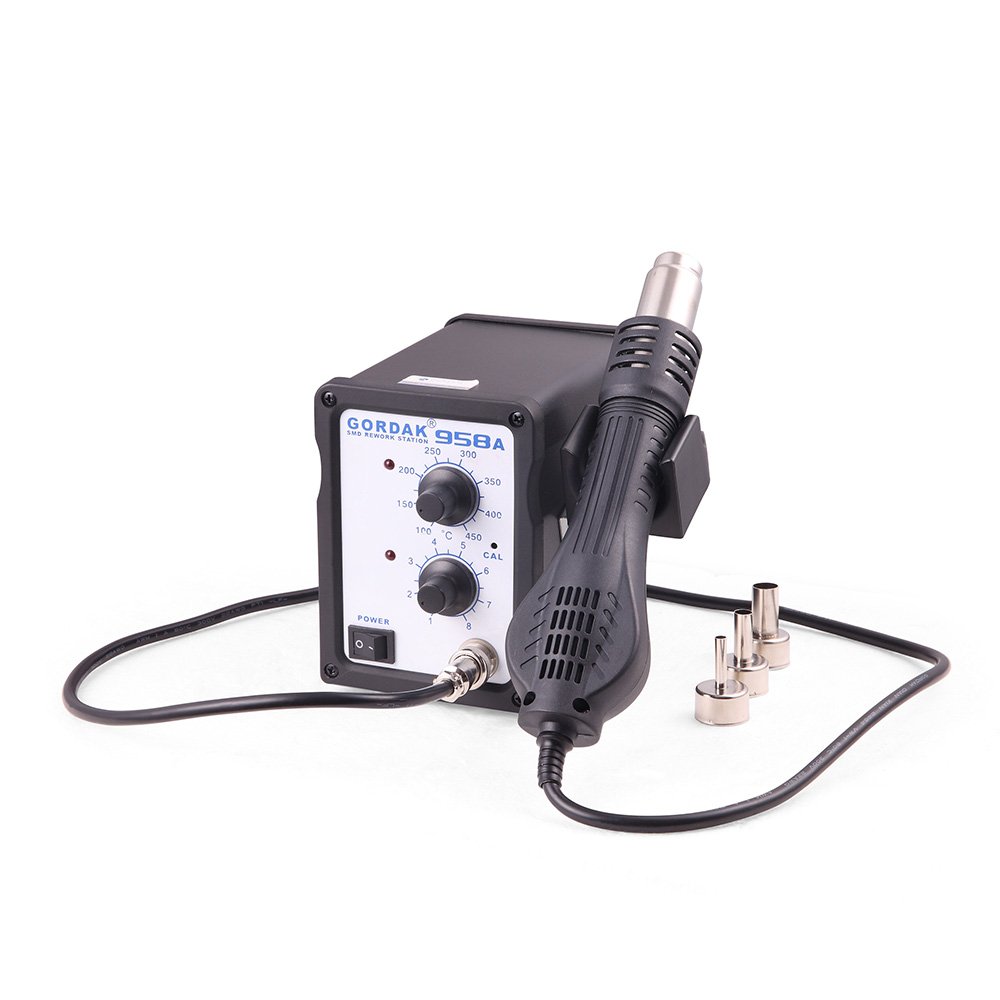集成电路 (IC) 芯片是几乎所有现代电子产品的核心。无论是修理损坏的电路板还是升级元件,更换集成电路芯片都需要精确度和正确的工具。A 热风返修站 为安全拆卸和安装集成电路芯片(尤其是表面贴装器件 (SMD))提供了理想的解决方案,而不会损坏周围的印刷电路板。
作为值得信赖的专业焊接和返修设备制造商,Gordak Electric 提供本指南,帮助您使用我们的热风返修工作台成功地进行 IC 更换。
为什么使用热风返修站更换集成电路?
集成电路芯片通常有多个排列紧密的引脚或焊盘(如 SOIC、QFP 或 BGA 封装)。传统的焊接工具可能无法提供这些元件所需的控制或热覆盖范围。热风返修站可实现以下功能
- 均匀加热 横跨所有引脚,实现清洁拆焊
- 非接触式操作减少机械损坏的风险
- 可控温度和气流防止 PCB 过热

所需工具
- 热风返修站(如 Gordak 850、850A、850B、857、857D、958、958A 和 958D)
- 防静电镊子或真空工具
- 烙铁(用于修饰或焊盘准备)
- 焊芯和/或吸锡器
- 焊膏或细焊锡丝
- 通量
- 异丙醇和无绒布湿巾
- 设置防静电工作站
更换集成电路芯片分步指南
1. 准备工作
- 打开热风返修站的电源,根据焊料和印刷电路板的类型将温度设定在 280°C 至 350°C 之间。
- 将气流调节到适中的水平,以防止附近的部件移位。
- 在集成电路周围涂上助焊剂,以便清洁拆焊和防止氧化。
- 将印刷电路板固定在防静电垫子上,并佩戴防静电腕带。
2. 取出故障集成电路芯片
- 选择能均匀覆盖切屑的喷嘴尺寸。
- 将热风枪放在集成电路上方约 2-4 厘米处。
- 将喷嘴在芯片上轻轻打圈,以均匀加热。
- 几秒钟后,当焊料融化后,抬起芯片 用镊子或真空拾取工具轻轻拾取。
- 避免用力--如果芯片不易移动,可继续加热几秒钟。
3. 清洁护垫
- 使用带焊芯的烙铁清除 PCB 焊盘上多余的焊料。
- 用异丙醇和无绒布清洁该区域。
- 在放大镜下检查衬垫,确保没有损坏或翘起。
4. 定位新的集成电路芯片
- 涂上一层薄薄的焊膏,或使用细焊锡丝在焊盘上轻轻镀锡。
- 根据 1 号引脚标记正确对准新集成电路。
- 在回流焊过程中,使用助焊剂帮助焊料正常流动。
5. 用热空气焊接新集成电路
- 将热风返修站设置到与之前相同的温度范围。
- 从上方均匀地轻轻加热集成电路,直到焊料融化,每个引脚都固定到位。
- 当表面张力将销钉拉到适当位置时,注意观察自对准效果。
- 让木板自然冷却后再进行处理。
6. 检查焊点
- 冷却后,检查所有引脚的焊接覆盖面和对齐情况。
- 使用万用表的连续性模式检查短路或连接不良。
- 用酒精清洗助焊剂残留物。
安全与质量小贴士
- 使用适当的气流--太强的气流会吹掉部件或损坏附近的部件。
- 避免过度受热,以防印刷电路板翘曲或分层。
- 在处理贵重电子设备之前,先在废弃电路板上练习,以增强信心。
- 始终在通风良好的地方操作或使用排烟装置。
为什么选择高达克电气公司
在 Gordak Electric,我们为初学者和专业人员提供耐用、精确和用户友好型热风返修站。我们的产品支持各种集成电路封装类型和返修应用,帮助您安全高效地完成维修。
如需进一步了解我们的产品系列或索取报价,请联系我们:
电子邮件: info@gordakelec.com



